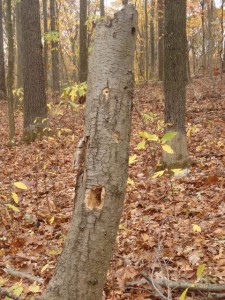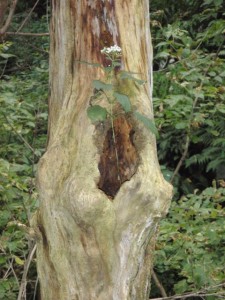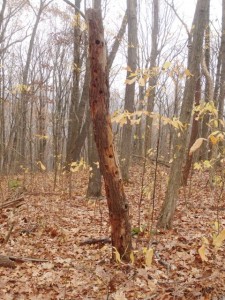Mariton: Stumping for Wildlife
by Tim Burris, Preserve Manager
The credit for this idea belongs to Marilyn, a member of the Mariton’s informal Bird Club. She was having tree work done at her house after Hurricane Sandy, and while the crew was there she had concerns about a tree with branches hanging over her house and the neighbor’s property. Common practice would have been to cut the tree completely down, but she asked the company to cut the tree to a height that would not endanger structures if it fell. She stood resolute in face of the tree trimmers’ misgivings and ended up with a standing tree trunk. Two years later, that tree trunk provides a natural bird feeder and wildlife habitat in her yard.
She told me about her plans at the time and I thought it was brilliant. Lots of sources suggest leaving dead standing trees for wildlife, but Marilyn’s idea of converting a tree that needed to be removed into a standing stump is a novel approach. As birders, we reflexively check out snags, dead trees, and stumps because we know they attract insects which in turn attract a variety of birds like woodpeckers, chickadees, and nuthatches. These snags also provide hunting perches for birds like bluebirds, flycatchers and hawks. The photo examples in this article are from Mariton. Some will continue to stand for decades; some are nearly compost. All have been visited by wildlife regardless of whether they are skinny, wide, short or tall.
So, if you need a tree removed in your yard because it poses a hazard, you might consider leaving the trunk at a safe height. Nature made the stumps in these photos, but there is no reason we can’t simulate what nature does in our own yard (just as we do when we put up bird boxes). One of Marilyn’s great success stories is watching Hairy Woodpeckers visit the stump that she left standing for wildlife.




